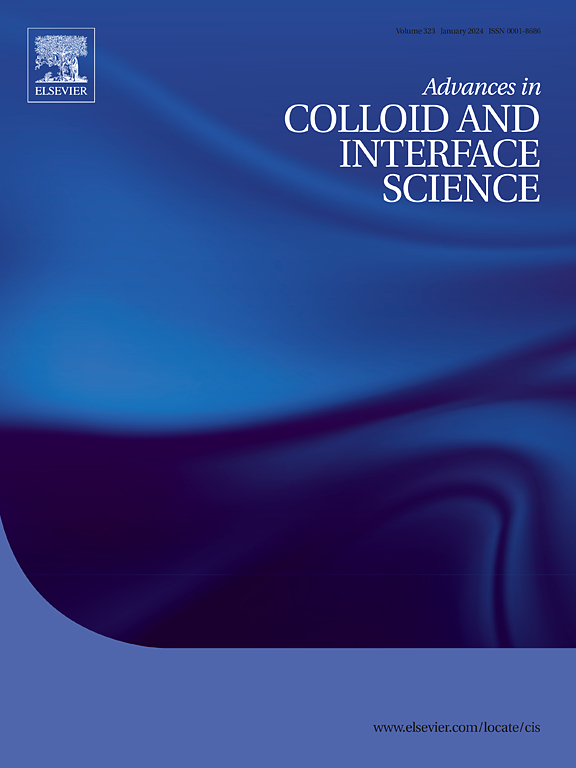微流体驱动的核/壳纳米结构组装:通过颗粒表征和分子动力学来理解封装过程。
IF 15.9
1区 化学
Q1 CHEMISTRY, PHYSICAL
引用次数: 0
摘要
在杂化纳米材料领域,核/壳纳米粒子的结构提供了一种有效的策略,可以用聚合物或其他合适的材料包裹粒子,从而形成具有不同结构特征的纳米复合材料。聚合物外壳可以通过纳米沉淀形成,通过控制流体流动、流体混合、微流体调制装置等功能进行优化。除了工艺优化之外,聚合物封装的成功很大程度上取决于核壳材料之间不同的化学环境所产生的良好的分子相互作用,这些相互作用促进了核/壳纳米结构的形成。因此,了解颗粒表面相关性质和核壳相互作用特征,有助于全面控制核壳结构的形成。在我们的研究中,我们采用微流体辅助筛选不同的MSN核与不同的带电荷的葡聚糖衍生聚合物,我们使用动态光散射(DLS)、透射电子显微镜(TEM)成像和分子模拟(MD)来分析相互作用能和分子相互作用。我们的研究结果表明,聚合物在MSN核周围的自组装主要发生在反电荷实体(核和壳)之间。从分子的角度来看,除了静电相互作用外,氢键相互作用也有助于稳定聚合物的组装。相反,我们的数据表明,当π -cation和van der Waals相互作用占主导地位时,无论颗粒表面电荷如何,都可以完成对MSN核的封装。因此,通过结合形态学表征和计算研究的分子见解,我们总结了核/壳纳米结构的合成机制。本文章由计算机程序翻译,如有差异,请以英文原文为准。
Microfluidics-enabled core/shell nanostructure assembly: Understanding encapsulation processes via particle characterization and molecular dynamics
In the realm of hybrid nanomaterials, the construction of core/shell nanoparticles offer an effective strategy for encompassing a particle by a polymeric or other suitable material, leading to a nanocomposite with distinct features within its structure. The polymer shell can be formed via nanoprecipitation, optimized by manipulating fluid flow, fluid mixing, modulating device features in microfluidics. In addition to the process optimization, success of polymer assembly in encapsulation strongly lies upon the favorable molecular interactions originating from the diverse chemical environment shared between core and shell materials facilitating formation of core/shell nanostructure. Therefore, understanding particle surface related properties and interaction profile of core/shell, is pertinent to fully harness control over core/shell structure formation. In our study, employing microfluidics-assisted screening of diverse MSN cores with contrasting charged dextran derived polymers, we conducted detailed characterization using dynamic light scattering (DLS), transmission electron microscope (TEM) imaging, and molecular simulations (MD) for analyzing interaction energies and molecular interactions. Our findings reveal that self-assembly of a polymer around the MSN cores majorly proceeds among counter charged entities (core and shell). From molecular perspective, in addition to the electrostatic interactions, hydrogen bonded interactions also contribute to stabilizing polymer assembly. Contrarily, out data reveals that in case pi-cation and van der Waals interactions are dominant, encapsulation of MSN cores accomplishes regardless of particle surface charge. Therefore, by integrating morphological characterization and molecular insights from computational studies, we summarize the synthesis mechanism of core/shell nanostructures.
求助全文
通过发布文献求助,成功后即可免费获取论文全文。
去求助
来源期刊
CiteScore
28.50
自引率
2.60%
发文量
175
审稿时长
31 days
期刊介绍:
"Advances in Colloid and Interface Science" is an international journal that focuses on experimental and theoretical developments in interfacial and colloidal phenomena. The journal covers a wide range of disciplines including biology, chemistry, physics, and technology.
The journal accepts review articles on any topic within the scope of colloid and interface science. These articles should provide an in-depth analysis of the subject matter, offering a critical review of the current state of the field. The author's informed opinion on the topic should also be included. The manuscript should compare and contrast ideas found in the reviewed literature and address the limitations of these ideas.
Typically, the articles published in this journal are written by recognized experts in the field.

 求助内容:
求助内容: 应助结果提醒方式:
应助结果提醒方式:


